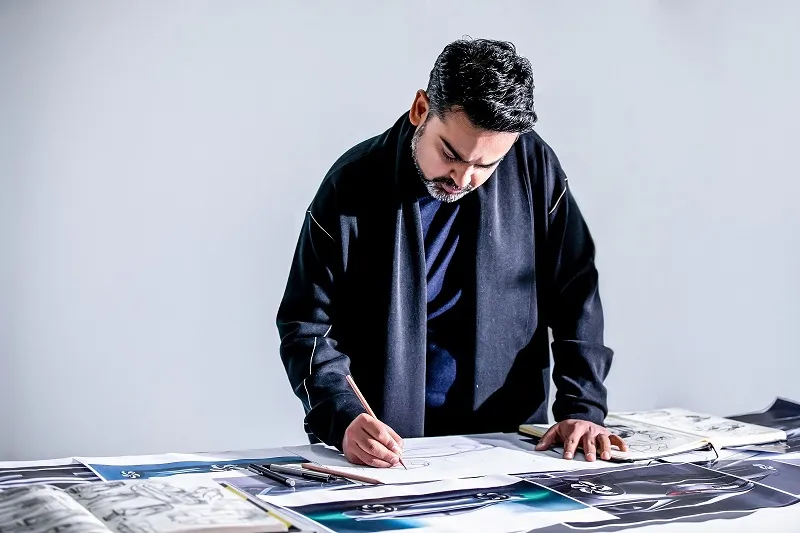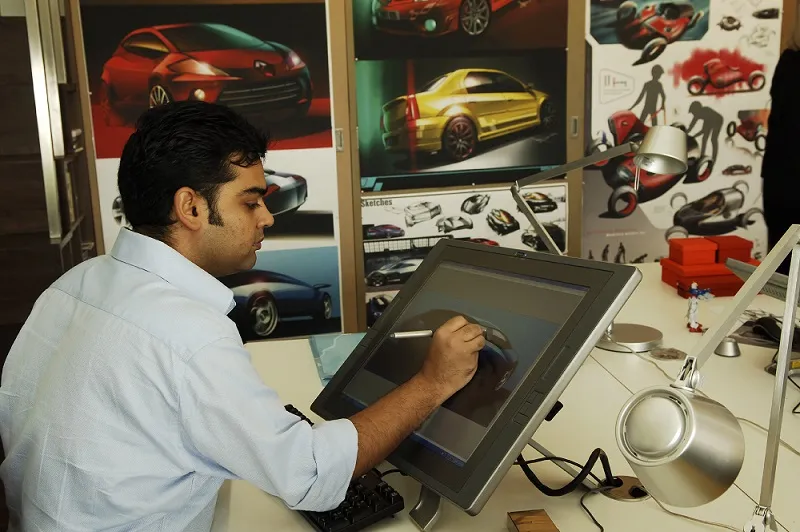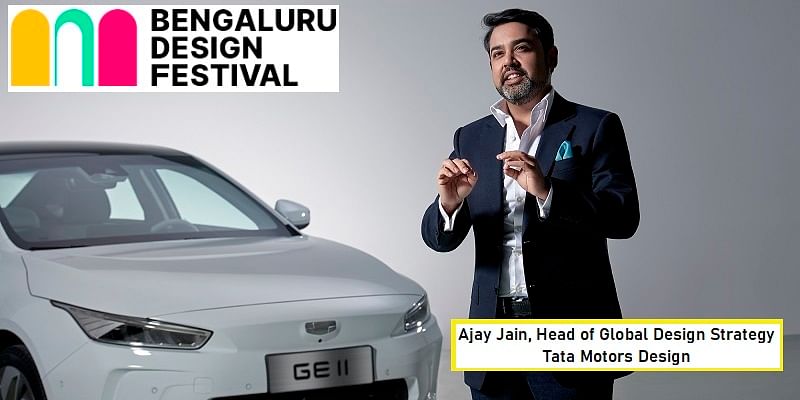Ajay Jain is the Head of Global Design Strategy for Tata Motors Design. In addition to car design, his expertise is in brand strategy, design management, and product leadership with multidisciplinary creative teams and processes.
Ajay is a speaker at the Bengaluru Design Festival, for which YourStory is the media partner. See YourStory’s earlier coverage of other design conferences such as DesignUp from 2022, 2021, 2020, 2019, 2018 and 2017.
Also read YourStory’s Book Review section with takeaways from over 350 titles, and our d-Zen (‘Design Zen’) section for more design resources.
Ajay was earlier Head of the Concept Design Group at Mahindra India Design Studio, and Senior Manager, Strategic Design at GEELY. He studied at the ArtCenter College of Design (Switzerland) and Daly College (Indore).
Ajay joins us in this interview on the importance of design, resilient processes, and tips for entrepreneurs.

Ajay Jain
Edited excerpts from the interview:
YourStory [YS]: Many of our readers are techie founders. What’s your advice to them on when and how they should integrate design into their startup journeys?
Ajay Jain [AJ]: Like technology, design is a key differentiator for any product, service, or experience. It is my view that from the time of conception, creating brand values and a design manifesto, all are imperative to create a sustainable business model and justify choices.
Indeed, differentiating by design starts with the very initial stages of branding or making a pitch.
YS: What are some outstanding examples of effective design you have seen during the COVID-19 pandemic?
AJ: At Tata Motors, the hugely successful AVINYA Concept Car was born during the lockdown. One of the most successful outcomes is not a product but the innovations that have happened in the design process.
Many designers experimented with software and open source tools in the absence of access to fully-equipped design studios and workshops. As a result, we have circumvented the procedural obstacles and implemented streamlined design processes with high-quality results.
Finally, on a more personal note, having a physical distance and communicating via a sheet of glass has allowed my own leadership style to develop and mature, to communicate more effectively and delegate and trust more.
One’s urge to constantly look over a creative individual’s shoulder is constrained, allowing for greater freedom of creative expression. The results have been illuminating and exciting.
YS: In the post-pandemic era, what is the key role of designers?
AJ: At Tata Motors Design, we are realising that the transition from creators of form and surface has accelerated creators of holistic experiences. Moreover, society has developed a healthy appreciation and insight into authenticity and consciousness.
This is a fantastic opportunity and challenge for designers to create with a multi-sensory approach to design.

YS: How should designers strike that delicate balance between ‘stick to your vision’ and ‘adapt to a changed world’?
AJ: Good designers have the courage of their conviction, which is derived by calibrating and sponging on a diverse range of analytical and intuitive stimuli.
Their beliefs are a result of forecasting the changes in society which empowers them with the vision and energy to implement their ideas all the way to fruition by finding a delicate balance between their objectives and constraints.
YS: Is there such a thing as the ‘ideal age’ for a creative person, or can the creative bug strike you at any time?
AJ: The age of the creator is less important than having empathy with the target customer’s generation. Designing for oneself is not a luxury that designers can always hope to have.
Designers only get obsolete when they stop learning and absorbing from everything and everyone around them.
YS: Who are some of the designers you admire the most today? What is it that makes them special?
AJ: Martin Uhlarik is the Global Head of Tata Motors Design.
His cultural sensitivity and global exposure make him uniquely positioned to take Tata Motors Design into a new era: from styling to design, from ‘form centric’ to ‘human centric’, from a focus on a moving shape to mobility space, from exclusive product to product and experience, from international to India-inspired, from an era of creating impact to one of creating permanent emotional connections.

YS: What are the top three success factors for government and industry to work together and grow the field of design in their countries?
AJ: Vocation is of course vital to prepare future generations of designers and creative professionals. The industry needs to take a lead in influencing the curriculums of design education by regularly engaging with government bodies and educational institutions.
Good leaders create good designers while defining the framework. The organisation needs to be strategic and clear about their expectations and desires for exploration and interpretations of the brief. Everyone is responsible for setting up and enforcing a robust legal framework and code of professional ethics and compliance.
YS: It is one thing to be a creative person – how should managers scale up organisational creativity? What are the challenges of being a design manager?
AJ: The design principles stay the same, the relentless pursuit of perfection and the thirst for knowledge and empathy doesn’t diminish. However, the focus and vision evolve from micro to macro and expertise migrates to communicating, inspiring and empowering rather than crafting by oneself.
One needs to curate a team with distinct and complementary talents and get them to work in harmony. Developing creative individuals by nurturing can encourage them to achieve their full potential while contributing and collaborating in meaningful ways.
Communicating clearly and honestly one’s expectations and objectives, while trusting them implicitly, can deliver results beyond one’s own expectations and capabilities. It’s no different from a long-term design project except that one is designing the designers.

Ajay Jain
YS: What are your favourite design conferences around the world?
AJ: I am very nostalgic about the slow demise of motor shows in the car industry as we transition towards independent car launch events.
In fact, it was after visiting the first Indian Auto Expo in 1986 that I might have decided to become a car designer. Car shows, and the annual Geneva Motor Show specifically, have been a major part of my entire student and professional life.
Having all the world’s concepts and car launches under one roof is very effective to identify key trends and make instant comparisons. It is equally inspiring and enlightening to get exposed to different creative disciplines, to challenge the status quo of one’s creative discipline and industry.
From this perspective, I am always inspired by the Venice Art and Architecture Biennales. Italy also has the Salone del Mobile in Milan, which isn’t strictly a furniture design exhibition, but touches on brand, retail, design, and architecture.
YS: You have travelled and spoken extensively around the world. What are some variations you see in the ‘design quotient’ of different countries? How does India fare in this regard?
AJ: In India, we tend to have a lot of conferences and seminars where we ‘talk’ about design. The most successful design and art exhibitions are ones that allow the audience to interact with the work and experience the journey of creation.

Ajay Jain, Tata Motors
YS: What are some good examples of design you have come across in the context of social entrepreneurs and non-profit organisations?
AJ: I am impressed by design for social change’s systemic approach to solving real-world problems. There are some solar cookers and bicycle-powered washing machines that are very sustainable, innovative, and inclusive.
The one that stands out for me is Sulabh Shauchalaya, which solves the sanitation and energy needs of this nation’s marginalised population.
YS: What is your parting message to the startups and aspiring designers in our audience?
AJ: One piece of advice that I’d like to give to budding designers is to believe in yourself, your dreams, your ideas, and your vision. You need to have faith in yourself if you want others to have faith in you.




![Read more about the article [Funding alert] Cashify raises $90M in Series E round led by NewQuest, Prosus](https://blog.digitalsevaa.com/wp-content/uploads/2022/06/cashify-final-1655912399689-300x150.png)





